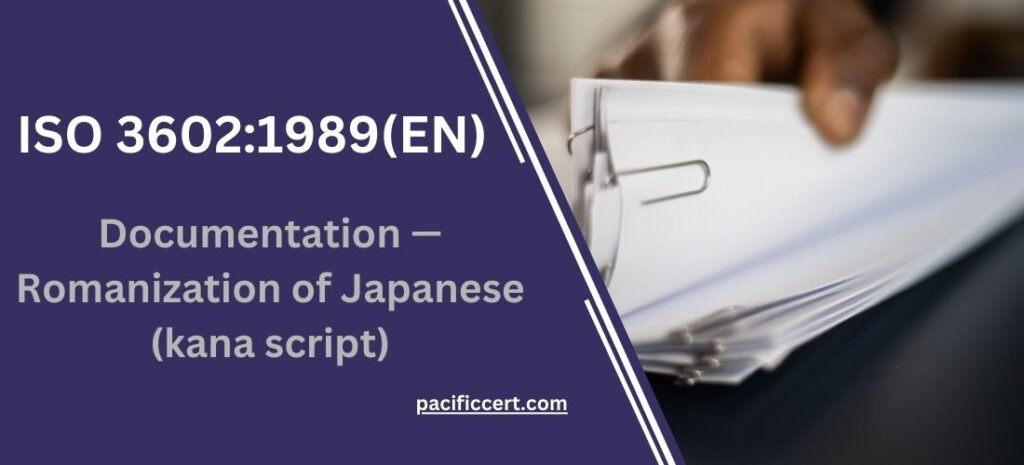
Documentation — Romanization of Japanese (kana script)
ISO 3602 was created by Technical Committee ISO/TC 46, Documentation.
ISO 3602:1989(EN) defines a system for the Romanization of the present-day Japanese written language. Unrestricted application for the system requires that the Romanize possess a detailed knowledge of the language in its present-day written form.
Standards on the conversion of systems of writing
ISO 3602:1989 is one of a series of International Standards dealing with the conversion of systems of writing. The aim of ISO 3602:1989 is to provide a means for international communication of written messages in a form that permits the automatic transmission and reconstitution of these by men or machines. The system of conversion must, in this case, be univocal and entirely reversible.
This means that no consideration should be given to phonetic and aesthetic matters nor to certain national customs. All these considerations are ignored by the machine performing the function.
The adoption of ISO 3602:1989(EN) for international communication leaves every country free to adopt, for its own use. A national standard which may be different, on condition that it be compatible with ISO 3602:1989. The system proposed herein should make this standard possible. And be acceptable for international use if the graphisms it creates are such that they may be converted automatically into the graphisms used in any strict national system.
ISO 3602:1989(EN) can be used by anyone who has a clear understanding of the system. And is certain that it can be applied without ambiguity. The result obtained will not give a correct pronunciation of the original text in a person’s own language. But it will serve as a means of finding automatically the original graphism. And thus allow anyone who has a knowledge of the original language to pronounce it correctly.
The adoption of national standards compatible with this ISO 3602:1989 will permit the representation, in an international publication, of the morphemes of each language. According to the customs of the country where it is spoken. It will be possible to simplify this representation in order to take into account the number of the character sets available on different kinds of machines.
The words in a language, which are written according to a given script (the converted system), sometimes have to be rendered according to a different system, normally used for a different language. This procedure is often used for historical or geographical texts, cartographical documents. And, in particular, bibliographical work where characters must be converted from different writing systems into a single alphabet. To allow for alphabetical intercalation in bibliographies, catalogues, indexes, toponymic lists, etc.
It is indispensable in that it permits the univocal transmission of a written message between two countries using different writing systems or exchanging a message the writing of which is different from their own.
It thereby permits transmission by manual, mechanical. As well as electronic means.
The two basic methods of conversion of a system of writing are transliteration and transcription.
In principle, this conversion should be made character by character. Each character of the converted graphical system is rendered by only one character of the conversion alphabet, this being the easiest way. To ensure the complete and unambiguous reversibility of the conversion alphabet in the converted system.
When the number of characters used in the conversion system is smaller than the number of characters of the converted system, it is necessary to use digraph or diacritical marks. In this case one must avoid as far as possible arbitrary choice and the use of purely conventional marks. Also, try to maintain a certain phonetic logic to give the system a wide acceptance.
It must be accepted, however, that the graphism obtained may not always be correctly pronounced. According to the phonetic habits of the language (or of the languages). Which usually use(s) the conversion alphabet. On the other hand this graphism must be such that the reader who has a knowledge of the converted language may mentally restore unequivocally the original graphism. And thus pronounce it.
Retransliteration is the process whereby the characters of a conversion alphabet are transformed back into those of the converted writing system. It is the exact opposite of the transliteration process in that the rules of a transliteration system are applied in reverse. In order to reconvert the transliterated word to its original form.
Transcription is the process whereby the pronunciation of a given language is noted by the system of signs of a conversion language. A transcription system is of necessity based on the orthographical conversions of the conversion language. Transcription is not strictly reversible.
Transcription may be used for the conversion of all writing systems. It is the only method that can be used for systems that are not entirely alphabetical or syllabic. And for all ideophonographical systems of writing such as Chinese.
To carry out romanization, the conversion of non-Latin writing systems to the Latin alphabet. Either transliteration or transcription or a combination of the two may be used. Depending on the nature of the converted system.
A conversion system proposed for international use may call for compromise and the sacrifice of certain national customs. It is therefore necessary for each community of users to accept concessions, fully abstaining in every case from imposing as a matter of course solutions. That are actually justified only by national practice
If you need more support with ISO 3602:1989(EN), please contact us at +91-8595603096 or support@pacificcert.com
Read About: ISO 23640









